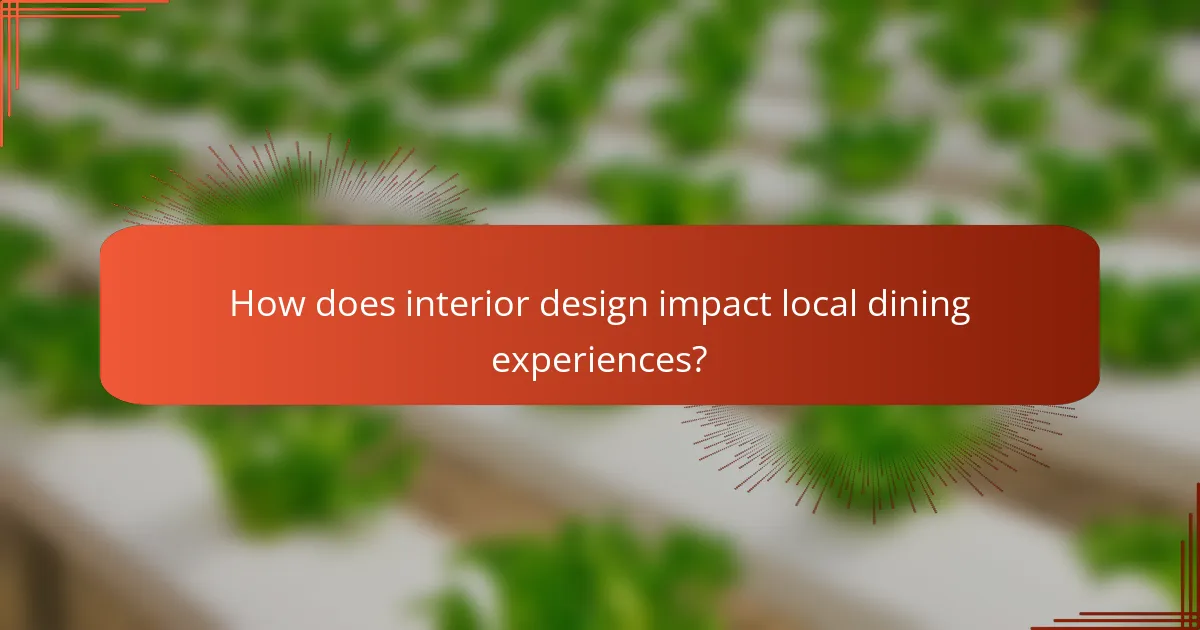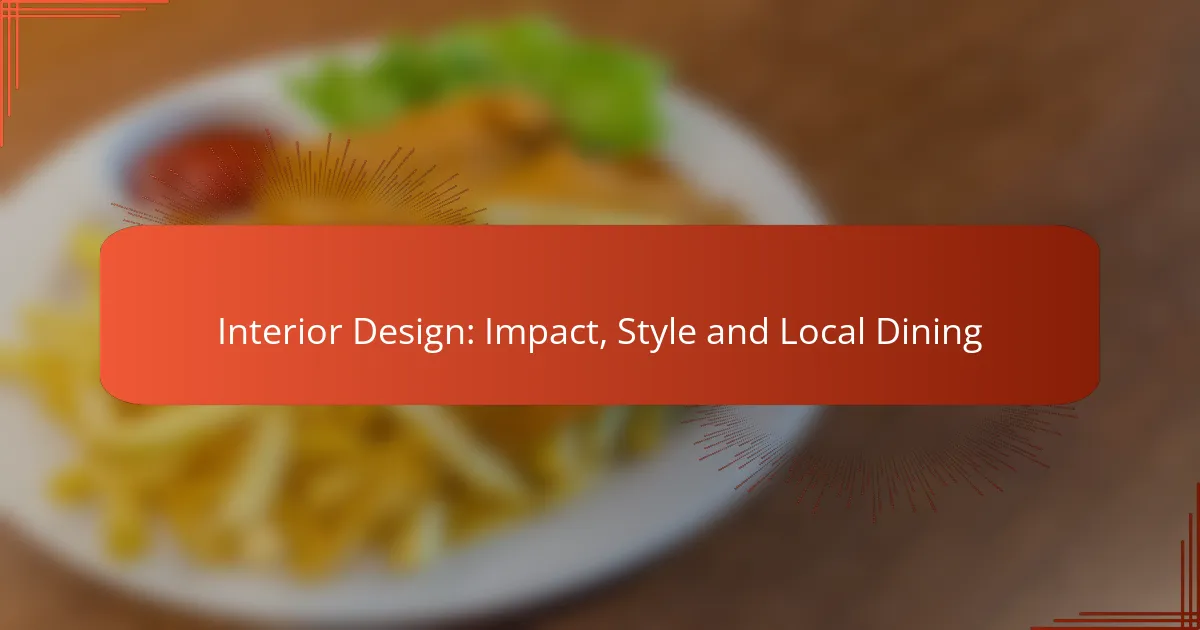Interior design plays a crucial role in shaping local dining experiences, influencing everything from atmosphere to customer interactions. By selecting the right style—be it modern minimalist, rustic farmhouse, or industrial chic—restaurants can create unique environments that attract specific demographics and enhance overall enjoyment. A thoughtful design not only aligns with brand identity but also encourages longer visits and increased spending, ultimately driving repeat business.

How does interior design impact local dining experiences?
Interior design significantly influences local dining experiences by shaping the overall atmosphere and customer interactions. Thoughtfully designed spaces can enhance enjoyment, encourage longer visits, and even affect spending behavior.
Enhances ambiance and atmosphere
A well-designed interior creates a specific ambiance that can evoke emotions and set the tone for the dining experience. Elements such as lighting, color schemes, and furniture arrangement contribute to a welcoming or sophisticated atmosphere, depending on the restaurant’s theme.
For example, warm lighting and earthy tones may create a cozy environment suitable for family dining, while sleek, modern designs with bright accents can attract a younger crowd seeking a vibrant experience. Consideration of local culture can further enhance this effect, making the space feel more relatable to patrons.
Influences customer behavior
Interior design can directly impact how customers behave within a dining space. Layouts that promote easy movement and social interaction can encourage guests to stay longer and order more. Conversely, cramped or poorly designed spaces may lead to discomfort and quicker turnover.
For instance, restaurants with open layouts and communal tables often foster a sense of community, enticing customers to engage with one another. Additionally, strategic placement of menu boards or specials can guide customer choices and increase sales.
Improves space functionality
Effective interior design maximizes the functionality of a dining space, ensuring that both staff and customers can navigate it efficiently. This includes considering the flow of service, from the kitchen to the dining area, and how patrons move through the space.
For example, a well-planned kitchen layout can reduce wait times and improve service speed, while comfortable seating arrangements can enhance guest satisfaction. It’s essential to balance aesthetics with practicality to create a space that is both visually appealing and operationally efficient.

What are popular interior design styles for restaurants?
Popular interior design styles for restaurants include modern minimalist, rustic farmhouse, and industrial chic. Each style creates a unique atmosphere that can enhance the dining experience and attract specific customer demographics.
Modern minimalist
Modern minimalist design emphasizes simplicity and functionality, often featuring clean lines and a neutral color palette. This style typically uses open spaces, allowing for a sense of calm and focus on the dining experience.
Key elements include minimal décor, sleek furniture, and strategic lighting. When implementing this style, consider using natural materials like wood or stone to add warmth without cluttering the space.
Rustic farmhouse
Rustic farmhouse design evokes a cozy, homey feel, often incorporating reclaimed wood, vintage accents, and earthy colors. This style aims to create a welcoming environment that feels familiar and comfortable to guests.
Consider using barn doors, exposed beams, and vintage farm equipment as décor. Pairing these elements with soft lighting can enhance the inviting atmosphere, making it ideal for casual dining experiences.
Industrial chic
Industrial chic design combines raw materials and urban elements, featuring exposed brick, metal fixtures, and concrete floors. This style is characterized by a blend of modern and vintage aesthetics, appealing to a trendy clientele.
To achieve this look, incorporate large windows for natural light and use furniture with a mix of textures. Keep in mind that while this style can be visually striking, it’s important to maintain comfort and functionality for diners.

How to choose the right interior design for your restaurant?
Choosing the right interior design for your restaurant involves understanding your target audience, evaluating the physical space, and aligning the design with your brand identity. A well-thought-out design can enhance customer experience and drive repeat business.
Assess target audience preferences
Understanding your target audience is crucial in selecting an interior design that resonates with them. Consider demographics such as age, income level, and dining preferences. For instance, a casual eatery may benefit from a vibrant, relaxed atmosphere, while a fine dining restaurant might opt for a more sophisticated and elegant design.
Conduct surveys or focus groups to gather insights on what potential customers value in a dining experience. This feedback can guide your design choices, from color schemes to furniture styles.
Evaluate space and layout
The physical space of your restaurant significantly impacts the interior design. Measure the dimensions of your area and consider the flow of movement for both customers and staff. An efficient layout should facilitate easy navigation while maximizing seating capacity.
Incorporate elements like open kitchens or bar areas to create a lively atmosphere. Ensure that your design complies with local regulations regarding accessibility and safety, which may dictate certain layout choices.
Consider brand identity
Your restaurant’s interior design should reflect its brand identity and mission. Whether you aim for a rustic charm or a modern aesthetic, every design element should align with your brand message. For example, a farm-to-table restaurant might use natural materials and earthy tones to emphasize its commitment to sustainability.
Utilize branding elements such as logos, color palettes, and themed decor to create a cohesive look. This not only enhances recognition but also fosters a memorable dining experience that encourages customer loyalty.

What are the costs associated with restaurant interior design?
The costs associated with restaurant interior design can vary significantly based on factors such as location, style, and materials used. Generally, expenses can be categorized into materials, labor, and ongoing maintenance, each contributing to the overall investment in creating an appealing dining environment.
Budgeting for materials
When budgeting for materials in restaurant interior design, consider the quality and type of finishes you want to use. Common materials include flooring, wall coverings, furniture, and lighting, with costs ranging from affordable options to high-end selections. For example, laminate flooring may cost around $2 to $5 per square foot, while hardwood can range from $5 to $15 per square foot.
It’s crucial to prioritize materials that align with your restaurant’s theme and durability needs. Investing in high-quality materials can lead to longer-lasting results, reducing the need for frequent replacements.
Labor costs for installation
Labor costs for installation can significantly impact your overall budget. These costs typically include hiring contractors, electricians, and specialized tradespeople, which can vary based on local labor rates. In urban areas, labor costs may be higher, often ranging from $50 to $150 per hour depending on the expertise required.
To manage labor expenses effectively, consider obtaining multiple quotes from different contractors and clearly outline your design vision to avoid unexpected costs. Planning the installation during off-peak times may also help reduce labor rates.
Ongoing maintenance expenses
Ongoing maintenance expenses are an essential part of restaurant interior design costs. Regular upkeep includes cleaning, repairs, and potential renovations to keep the space inviting and functional. Budgeting around 1-3% of your initial investment annually for maintenance can help ensure your restaurant remains in excellent condition.
Be proactive in scheduling routine maintenance checks, especially for high-traffic areas. This approach can prevent costly repairs down the line and maintain the aesthetic appeal of your dining environment.

What are the latest trends in restaurant interior design?
The latest trends in restaurant interior design focus on creating inviting, sustainable, and technologically advanced spaces. These trends enhance customer experience while reflecting a commitment to environmental responsibility and modern convenience.
Sustainable materials
Sustainable materials are increasingly being utilized in restaurant interiors to minimize environmental impact. Options like reclaimed wood, bamboo, and recycled metals not only reduce waste but also add unique character to the space.
When selecting materials, consider local sourcing to support the community and reduce transportation emissions. Look for certifications like FSC (Forest Stewardship Council) for wood products to ensure responsible sourcing.
Biophilic design elements
Biophilic design incorporates natural elements to create a connection between indoor spaces and the outdoors. This can include living walls, natural light, and the use of plants, which enhance the ambiance and promote well-being among patrons.
Integrating biophilic elements can improve air quality and reduce stress, making the dining experience more enjoyable. Consider using native plants that require less maintenance and are better suited to the local climate.
Technology integration
Technology integration in restaurant design enhances efficiency and customer engagement. Features like digital menus, contactless payment systems, and smart lighting can streamline operations and improve the dining experience.
When incorporating technology, ensure it aligns with the overall aesthetic and functionality of the space. Avoid overwhelming customers with too much tech; instead, focus on seamless integration that enhances service without detracting from the atmosphere.

How can local dining benefit from unique interior design?
Unique interior design can significantly enhance local dining experiences by creating an inviting atmosphere that attracts customers and encourages them to linger. Thoughtfully designed spaces can reflect the local culture and cuisine, making dining establishments more memorable and appealing.
Attracts diverse clientele
Unique interior design can draw in a wide range of customers by offering a visually stimulating environment that stands out from competitors. A well-designed space can cater to various demographics, from families to young professionals, by incorporating elements that resonate with different tastes and preferences.
For instance, a restaurant featuring local art and sustainable materials may appeal to environmentally conscious diners, while a modern, minimalist design could attract a younger crowd seeking trendy spots. Consider using a mix of seating arrangements, lighting, and decor to create distinct areas that cater to different dining experiences.
To maximize appeal, regularly update the interior design to reflect seasonal themes or local events. This keeps the atmosphere fresh and encourages repeat visits from both locals and tourists, ultimately boosting customer loyalty and word-of-mouth referrals.



